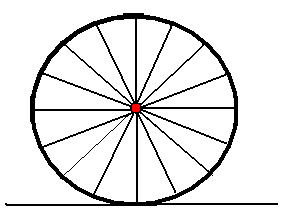
Friction and wheels
The early wagon wheel was a pretty simple affair. It was a large round thing mounted on an axle. Because the wheel could turn, we were no longer dragging the wagon. But this does not eliminate friction. Suppose the wheel turns on a fixed axle. The vertical force that the ground exerts on the wheel is about the same as the vertical force the wheel exerts on the axle (differing only by the weight of the wheel itself), and so the sliding friction force is also about the same. So how does the wheel help at all?
The point is that as the wheel turns once, the wagon moves forwards a
large distance, while the part of the wheel at the edge of the axle moves a much smaller
distance (the circumference of the wheel is much larger than the circumference
of the axle). Now consider the implications of the relationship
Energy transferred = force x distance
for one full turn of the wheel.
If the wheel is locked in place, we drag the wagon a large distance
against the friction force, and this takes a lot of energy. If the
wheel can turn, the hub of the wheel moves a small distance against the
same
So the wagon is a lot easier to pull when it has wheels that can turn, even
if the axle is made of sandpaper. Add to this the advantage
that the axle and hub can have smooth, hard, well lubricated surfaces instead of
the unpredictable surface of the ground, and you will see that the wheel
is a pretty wonderful invention.